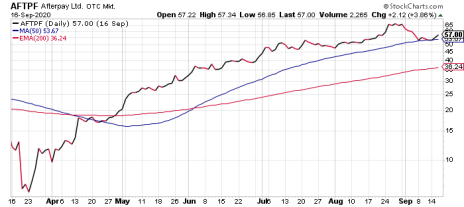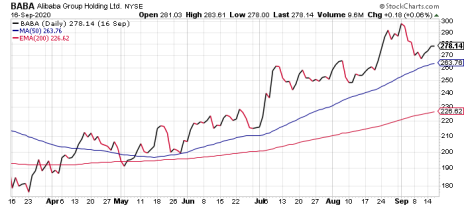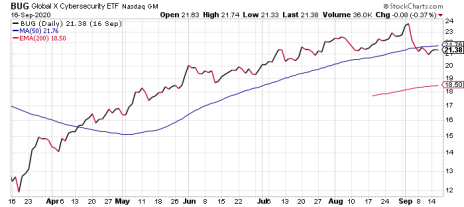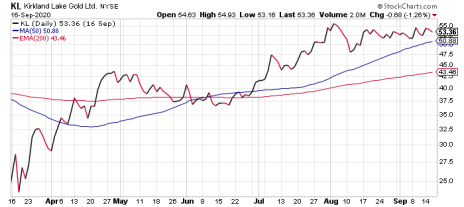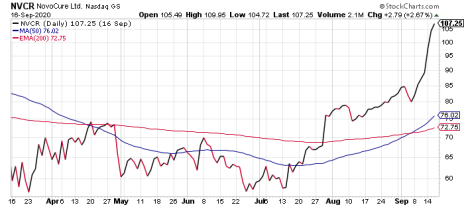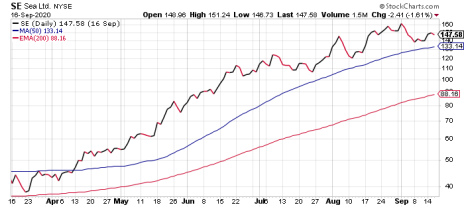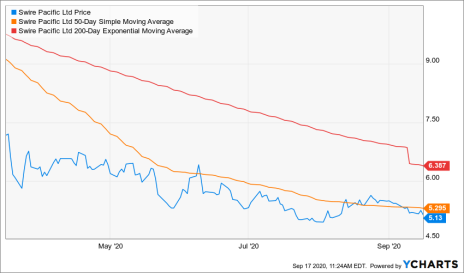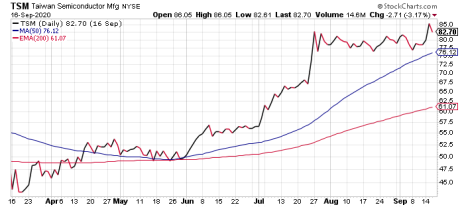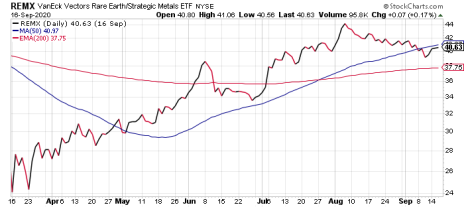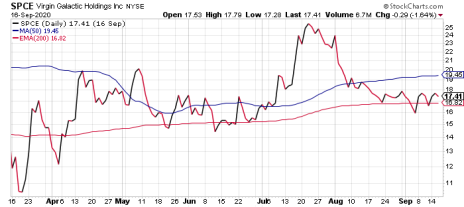The market’s uptrend is under a bit of pressure and the Fed’s dovish stand on interest rates is a sign of weakness that is unlikely to impress Wall Street. Nevertheless, Sea Limited (SE) has regained its momentum and NovoCure (NVCR) is up 35% over the past two weeks. And our emerging markets timer (EEM) is positive. This week we go to Australia for a new fintech idea that has been on a tear, but fortunately has pulled back for a decent entry point.
Cabot Global Stocks Explorer 719
[premium_html_toc post_id="215481"]
Going Down Under for Big Growth
Global stocks slumped on Thursday, with traders in Asia and Europe not reacting well to the interest-rate decision and outlook from the Federal Reserve.
Meanwhile, the performance of global stock markets so far in 2020 is all over the map. The Nasdaq, up 27%, leads the way unless you would like to include Venezuela, which is up 441%. The worst major market is London’s FTSE 100 index, down 20%, followed by Russia, down 19%.
The result is that the market value of Apple (AAPL) is now greater than the combined market value of the top 100 companies trading on the London Stock Exchange. This is quite remarkable. The FTSE 100 is trading at just 14 times earnings, with a dividend yield of 4.2%.
Meanwhile, the S&P 500 index is up 3%, Shanghai is up 6% and Japan’s TOPIX is up 1%. On the negative side, Mexico is down 17%, Brazil has fallen 15%, Australia has pulled back 10% and Hong Kong’s Hang Send has sunk 13%.
The trend favoring highly scalable, high growth U.S. technology stocks is unlikely to change in the near future but diversifying into different countries and sectors is a good idea as we move into the fourth quarter.
So today, we head to Australia for a high-flying fintech stock.
New Explorer Recommendation
Making Buying and Selling Easier
Afterpay (AFT.AX, AFTPF)
Many consumers, particularly millennials and Asian consumers, don’t like credit cards. Because of the fees and chargeback, retailers don’t like them either.
Enter Afterpay, which is revolutionizing the retail payment industry by effectively enabling interest-free loans at a growing number of retailers. With Afterpay, a consumer pays 25% of the purchase price, and Afterpay covers the rest.
Of course, you have to pay the money back but in a series of installments over several months, and there is no fee unless you’re late. For most users, it’s a zero-interest loan, and you only have to pay back what you borrowed.
So how does Afterpay make its money? The company charges the retailer a small fee on the sale. And retailers are signing up for the service in droves, because Afterpay drives sales with conversion rates up 20% and order values up 25%. Accepting Afterpay is a low cost way for retailers to boost sales and profits.
No wonder the company has almost 10 million active customers around the world, and 55,000 retailers participating in its network.
Founded in Australia in 2017, Afterpay has experienced some heady growth, with revenue going from $23 million in 2017 to $114 million in 2018 to $218 million in 2019. Last quarter’s year-over-year revenue was up 99.5%
And the stock (ticker symbol: AFTPF over the counter in the U.S.; AFT.AX on the Australian Securities Exchange) has been a rocket, but recently a new development has caused it to pull back, providing us with an attractive entry price. A copycat company called Affirm recently signed a partnership agreement with Shopify. This spooked investors in Afterpay.
But there is an important distinction between the two companies. Afterpay does not run a credit check on customers while Affirm always runs credit checks. And if you are using Affirm at a retailer that is outside the Shopify network, your loan is no longer interest-free and you might be paying 15% interest.
You might ask then, just how does Afterpay avoid the risks of default, if it runs no credit check? When a shopper selects the Afterpay option at checkout, the company’s software performs an internal fraud and repayment capability check. Afterpay only approves one order at a time, and if a repayment is not made on time, customers are not able to use Afterpay until the repayment is made (with a late fee payment). In addition, Afterpay incrementally raises the amount that a user can have outstanding at any one time based on its payment records. This is why Afterpay’s net transaction loss due to non-payment is only 0.6%.
By the way, Afterpay has been inking some partnership agreements to allow its users to more widely use its service both online and in physical stores.
Apple now allows shoppers to use Afterpay purchases in stores, using Apple Pay. Afterpay is also working with Alphabet (GOOG) to provide Afterpay capabilities with Google Pay. This move into mobile payment options gives Afterpay a huge advantage over its online competitors.
Take advantage of this pullback in Afterpay’s share price to build a half position in this momentum stock. BUY A HALF
Model Portfolio
| Stock | Price Bought | Date Bought | Price 9/17/20 | Profit | Rating |
| Afterpay (AFT.AX, AFTPF) | — | New | 54 | — | Buy a Half |
| Alibaba (BABA) | 102 | 1/27/17 | 274 | 169% | Hold |
| Cloudflare, Inc. (NET) | 24 | 4/30/20 | 36 | 50% | Hold a Half |
| Global X Cybersecurity ETF (BUG) | 17 | 4/30/20 | 21 | 24% | Hold a Half |
| Kirkland Lake Gold (KL) | 39 | 6/25/20 | 52 | 36% | Buy a Half |
| NovoCure, Ltd. (NVCR) | 68 | 7/23/20 | 109 | 60% | Buy |
| Sea Limited (SE) | 15 | 2/8/19 | 148 | 893% | Hold a Half |
| Swire Pacific (SWRAY) | 5.52 | 7/9/20 | 5 | -8% | Sell |
| Taiwan Semiconductor (TSM) | 81 | 8/6/20 | 82 | 1% | Buy a Half |
| Van Eck Rare Earths (REMX) | 35 | 6/11/20 | 41 | 15% | Buy a Half |
| Virgin Galactic (SPCE) | 7.34 | 12/5/19 | 17 | 135% | Buy |
| Visa (V) | 211 | 9/3/20 | 205 | -3% | Buy |
Portfolio Changes
Swire Pacific (SWRAY) - Move from HOLD A FULL POSITION to SELL.
Updates
Alibaba (BABA) shares inched up this week, as the much-anticipated Ant IPO will be reviewed by the Shanghai Stock Exchange this Friday, September 18. Analysts are already sharpening their pencil to make estimates for the world’s biggest shopping day of the year in China. November 11 is Singles Day, which last year accounted for $36 billion in sales in one day and this year is projected to hit $45 billion. The biggest challenge for Alibaba going forward is that JD.com (JD) is challenging them at the top end of the market, and Pinduoduo (PDD) is encroaching in many of the fast-growth, lower-tier markets. BABA remains a legacy hold. HOLD A HALF
Cloudflare (NET) shares were moved to “Sell a Half, Hold a Half” last week to lock in profits as the stock has lost momentum over the last month. This week was another flat week for the stock, but the company’s fundamentals remain strong. Cloudflare’s management projects revenue growth of 40% in the third quarter and for the full year with international business accounting for over 50% of its revenue. It continues to invest in international growth as part of its strategy to expand its global customer base. Cybersecurity is still very much in a growth trend and Cloudflare currently has over 3 million customers. We’ll watch this stock carefully and keep its rating a hold. HOLD A HALF
Global X Cybersecurity ETF (BUG) shares were up slightly this week.
Cybersecurity is one of the fastest-growing segments of IT spending. According to a study by IBM, chief information officers (CIOs) across the U.S. consistently rank cybersecurity as their top spending priority and in 2019, the average total cost of a data breach for a company was $3.9 million, with 36% of the cost coming from the loss of customer trust. HOLD A HALF
Kirkland Lake Gold (KL) shares have cooled a bit lately after a nice run, which is in line with the pullback in gold prices. Kirkland Lake is a Canadian company that excels at generating strong cash flow, producing $418 million in free cash flow through the first half of 2020. The company also has a strong balance sheet, lots of cash, little debt and industry-leading margins and its stock is trading at about 14 times estimated earnings.
I suggest you take a position in Kirkland if you have not yet done so. BUY A HALF
NovoCure (NVCR) shares had another stellar week, zooming from 89 to 107, and in just the last two weeks have jumped 35%. The company’s next quarter will be important to confirm strong top-line growth and that the company is close to turning positive on the profit front. NovoCure has significant growth potential. I still rate the stock a buy and encourage you to buy shares if you have not done so. BUY A FULL
Sea Limited (SE) shares regained their mojo this week, moving from 139 to 147. Part of the advance was likely sparked by a decision made in Sea’s largest market, Indonesia. Jakarta unfortunately went into another lockdown, which benefits Sea’s three digital growth drivers, especially gaming and e-commerce. In addition, the company launched a fresh-food delivery app in Indonesia today, showing its ability to break into new markets and challenging the local leader, Grab.
Sea’s rise has been supported by its stellar second-quarter growth, with revenue up 93.4% and active users increasing 61% year over year.
I will keep this a hold but any significant pullback will likely move my rating to a buy. HOLD A HALF
Swire Pacific (SWRAY) shares were again flat this week and while I was right that this stock’s downside was minimal, the market is telling us that its recovery is going to take longer than I anticipated. Those with a long time frame may wish to keep the stock but I’m moving this to sell and replacing it in the next issue with an idea with more near-term upside potential. MOVE FROM HOLD A FULL POSITION TO SELL
Taiwan Semiconductor (TSM) shares moved from 80 to 83 this week on heavy volume. Taiwan Semiconductor, which accounts for a staggering 56% of global chip production, fabricates chips at a scale of 5 nanometers. In comparison, Intel is making chips at 10 nanometers. In chip-making, fewer nanometers is better. TSM plans to stay a step ahead of rivals such as Samsung by starting to produce 3-nanometer chips in low volumes next year, with sizable production set for the second half of 2022. I recommend you buy a half position and put a 20% trailing stop-loss in place. BUY A HALF
VanEck Rare Earth/Strategic Metals ETF (REMX) shares seem to be stuck in a range of 40-42 but I think this is a smart bet and hedge on rising tensions between the U.S. and China especially given the intensity of pressure on the Taiwan situation. I encourage you to buy a half position for this reason and as a play on overall growth in advanced technology, if you have not already done so. BUY A HALF
Virgin Galactic (SPCE) shares didn’t do much this week as both UBS and Cowen have picked the stock up in the last few weeks by recommending it. Based on a Cowen survey, analysts see a total potential market of 2.4 million people with a net worth of more than $5 million globally. It then estimates Virgin Galactic can potentially fly about 3,400 passengers per year to suborbital space by 2030. Virgin Galactic has said it plans to fly founder Sir Richard Branson in the first quarter of 2021. I remain positive on this growth concept stock and suggest you build a full position. BUY A FULL
Visa (V) shares were treading water this week. I suggest you build a full position in this great core stock, which was just recently added to the Explorer portfolio. Visa’s markets are very scalable beyond its share of credit card-based network purchase volume in the U.S., already at 53%. In addition, more than half (55%) of its net revenue generated in the most recent fiscal year came from international markets.
Despite being a massive company in a stable product category of financial services, Visa is still putting up double-digit top-line growth numbers, and in each of the past seven years Visa’s operating margin has been above 60%, leaving plenty of cash flow to fund new products and services. BUY A FULL
The next Cabot Global Stocks Explorer issue will be published on October 1, 2020.
Cabot Wealth Network
Publishing independent investment advice since 1970.
CEO & Chief Investment Strategist: Timothy Lutts
President & Publisher: Ed Coburn
176 North Street, PO Box 2049, Salem, MA 01970 USA
800-326-8826 | support@cabotwealth.com | CabotWealth.com
Copyright © 2020. All rights reserved. Copying or electronic transmission of this information is a violation of copyright law. For the protection of our subscribers, copyright violations will result in immediate termination of all subscriptions without refund. No Conflicts: Cabot Wealth Network exists to serve you, our readers. We derive 100% of our revenue, or close to it, from selling subscriptions to its publications. Neither Cabot Wealth Network nor our employees are compensated in any way by the companies whose stocks we recommend or providers of associated financial services. Disclaimer: Sources of information are believed to be reliable but they are not guaranteed to be complete or error-free. Recommendations, opinions or suggestions are given with the understanding that subscribers acting on information assume all risks involved. Buy/Sell Recommendations: All recommendations are made in regular issues or email alerts or updates and posted on the private subscriber web page. Performance: The performance of this portfolio is determined using the midpoint of the high and low on the day following the recommendation. Cabot’s policy is to sell any stock that shows a loss of 20% in a bull market or 15% in a bear market from the original purchase price, calculated using the current closing price. Subscribers should apply loss limits based on their own personal purchase prices.

